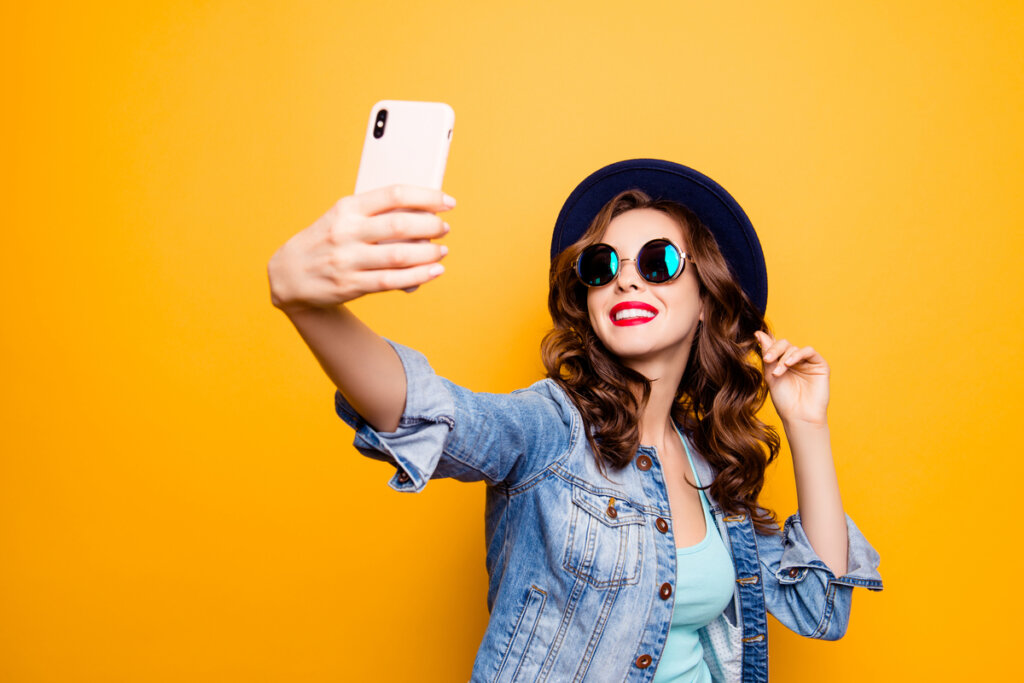Selfie Dysmorphia, Living Life Through Social Media Filters


Written and verified by the psychologist Valeria Sabater
Not long ago some of us probably dreamed of looking like Angelina Jolie, Brad Pitt, or Johnny Depp. However, today, things have changed a lot. In fact, nowadays, more and more people suffer from what is known as selfie dysmorphia.
This disorder defines an obsession. It’s the desire of wanting to be what you see on your mobile. This universe of filters puts forward improved and ideal images, and it seems that this is what we’re all looking for. The best version of ourselves. We retouch our faces via the addictive Snapchat app. We give ourselves thinner noses, bigger eyes, higher cheekbones…the list goes on.
As a matter of fact, some people hardly look at the real world. They spend most of their days in front of a screen that, like some strange spell or magic mirror, always shows them a seductive, perfect, captivating image. These people take between 25 and 50 selfies a day. Furthermore, hardly surprisingly, they can’t bear to look at themselves in the bathroom mirror. That’s because it tells the truth and doesn’t hide the dark circles or the double chins.
Technology can be pretty wonderful as well as useful. That’s so long as we use it wisely. However, it hides certain practices that often fall into the realms of the pathological. Let’s take a look at the specific disorder of selfie dysmorphia that, to date, hasn’t been included in any diagnostic manual.
More and more young people are now requesting cosmetic surgery. This is because they want to look like the digital images offered to them by apps like Snapchat.

Selfie dysmorphia
Some people become exasperated by disorders like selfie dysmorphia. “When will it end?” they ask. They see this condition as the most delusional disorder of recent years. However, there’s one thing we need to take into account. The fact that the world continues to advance and with each era comes certain peculiarities in the field of behavioral science and psychological health.
For example, it wasn’t too long ago that young people requested cosmetic surgery because they wanted to look like Barbie dolls. Nowadays, new technologies and apps fill our lives with filters and beautify everything, Along with this comes new psychological disorders.
In this parallel universe, the everyday and ordinary have no place. In fact, plain and ordinary faces become extraordinary, like something out of a Disney movie.
The clinical field has been warning of the impact of the selfie on mental health for a long time. For example, the University of York in Toronto (Canada) conducted research that mentioned how the need to take selfies and publish them continuously is correlated with lower self-esteem, feelings of insecurity, and social anxiety.
Without a doubt, we’re in an era where image is king. However, curiously, as humans, we’re feeling more insecure than ever with our physical appearance.
The digital universe and psychological problems
Not everything you see on your social networks is genuine. In fact, there’s a proliferation of fake news and fake social media accounts. Furthermore, the images and selfies that many users post don’t correspond 100 percent to reality. However, you may well be guilty of this yourself …adding a certain filter to a photo, for example, to improve its sharpness or color.
Is there anything wrong with this? Of course not. The problem comes when people can no longer publish photos of themselves without having retouched them first. Indeed, the pathological element of selfie dysmorphia is that a person no longer accepts their own image. In fact, they’re only able to accept themselves through those corrective, magical… and rather deceptive filters.
The repercussions of this reality are immense. This distorted self-perception often leads people to resort to cosmetic surgery. They need to touch up their bodies to fit that ideal vision these filters give them. In other cases, young people develop eating disorders.
How does selfie dysmorphia manifest itself?
In 2016, the Institute of Neurosciences in Kolkata (India) analyzed the phenomenon of selfie dysmorphia. They discovered that people who make excessive use of the selfie suffer from anguish and a dislike of their appearance.
The incidence of this is extremely high in young people. For this reason, many organizations warn of the need to increase psychoeducation for the teaching of the healthy use of technology.
With regards to selfie dysmorphia itself, here are its defining characteristics:
- Sufferers see themselves as having multiple physical defects on their faces.
- They see themselves as monstrously ugly.
- They spend a large part of the day on their cell phones. This means they neglect their other responsibilities.
- They can’t bear to look in the mirror. Furthermore, the image they have of their physical appearance is completely distorted.
- They only find well-being with the selfies they create through filters.
Selfie dysmorphia falls within the obsessive-compulsive spectrum. It’s highly underdiagnosed and leads people to experience feelings of great discomfort. In addition, the continuous need to take photos through apps to alter their real image takes them away from their obligations and from real and physical interaction with people.

How is selfie dysmorphia treated?
It’s recommended that the person suffering from this disorder doesn’t undergo cosmetic surgery. This is because, if they do have treatment, after each procedure, they tend to continue to reject themselves and feel frustrated. In addition, they experience a need to continue with more and more cosmetic interventions. It’s estimated that the percentage of patients who come to clinics with selfie dysmorphia maybe around 10 percent.
It’s crucial that sufferers first undergo specialized psychological care. Approaches like cognitive behavioral therapy are the most successful. In some cases, these people present an undiagnosed anxious-depressive state. For this reason, it’s important to consider each case individually and offer a personalized treatment plan.
Let’s not forget that this is a disorder that’s increasingly prevalent in today’s world.
All cited sources were thoroughly reviewed by our team to ensure their quality, reliability, currency, and validity. The bibliography of this article was considered reliable and of academic or scientific accuracy.
- Mills JS, Musto S, Williams L, Tiggemann M. “Selfie” harm: Effects on mood and body image in young women. Body Image. 2018 Dec;27:86-92. doi: 10.1016/j.bodyim.2018.08.007. Epub 2018 Aug 24. PMID: 30149282.
- Lazard L, Capdevila R. She’s so vain? A Q study of selfies and the curation of an online self. New Media & Society. 2021;23(6):1642-1659. doi:10.1177/1461444820919335
- Khanna, A., & Sharma, M. K. (2017). Selfie use: The implications for psychopathology expression of body dysmorphic disorder. Industrial psychiatry journal, 26(1), 106–109. https://doi.org/10.4103/ipj.ipj_58_17
This text is provided for informational purposes only and does not replace consultation with a professional. If in doubt, consult your specialist.








